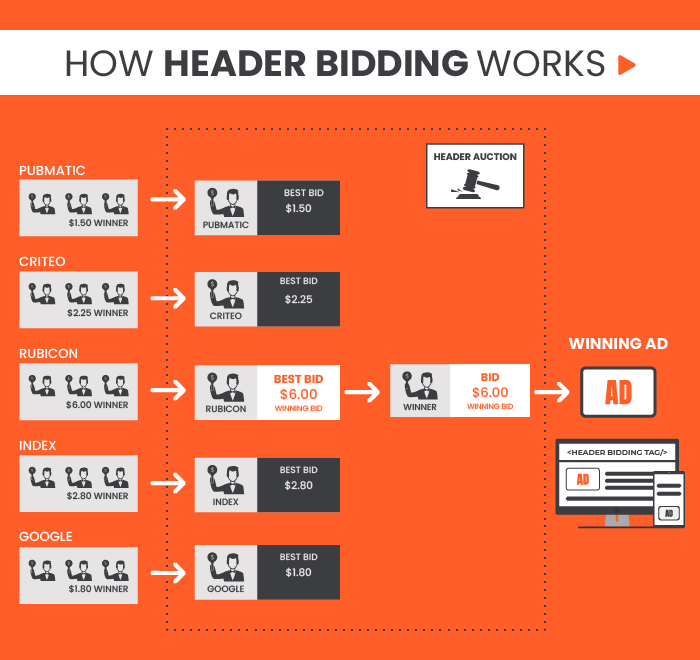
Despite the technology involved in the adtech space, there are still many inefficiencies and unfair practices that need to be ironed out. Header bidding is a solution that brings publishers and advertisers together.
What Is Header Bidding?
Header bidding is a process where many advertisers simultaneously bid (in real-time) in a digital auction to win ad space on your website. This auction occurs outside your primary ad server every time your pages load or whenever an ad unit refreshes.

For publishers, the primary advantage is it helps ensure you get the best deals on your ad space. To do this, you must ensure that you reach out to supply-side platforms (SSPs) and other demand partners to ensure you have many advertisers to bid on your inventory.
Header bidding is a more refined way of auctioning off your ad inventory. While it may be a bit more complex to implement than traditional methods (like waterfall bidding), it has many advantages that make it worth the hassle.
How Header Bidding Works
Here’s how the whole process play out when a visitor lands on a publisher’s page:
- A visitor clicks a link that takes them to a web page
- As the page loads, the short string of JavaScript in the page’s header makes a call to your demand partners or ad networks
- Each demand partner places a bid on the publisher’s ad inventory
- The winning bid is directed to the publisher’s ad server
- The publisher’s ad server then connects the user to the advertiser’s server and displays the winning ad
The process may involve several steps, but it takes less than a second from start to finish.
Header Bidding Vs. Waterfall Bidding
One of the most popular methods of buying and selling ad space was waterfall bidding. It has worked pretty well for the past few years, and some publishers are still reluctant to move away from it to embrace header bidding.
The question, however, is which is better: header bidding or waterfall bidding?
To properly understand why it is your better option, we need to briefly look at what waterfall bidding is and its pros and cons.
What Is Waterfall Bidding, and How Does It Work?
Waterfall bidding is one of the earliest forms of programmatic bidding.
Waterfall bidding is an old-school way of ad serving in which publishers set a floor price for their ad space. The publisher sets the priority for each advertiser or ad network they’re connected to.
When selling ad impressions using the waterfall bidding process, inventory is offered to advertisers at a fixed minimum price per impression. The first ad network to bid at that price gets the slot.
Another important aspect of waterfall bidding is that the bidders don’t get to bid randomly. Networks that rank higher, thanks to higher historical yield, get dibs on bidding.
In a sense, waterfall bidding isn’t accurate bidding at all.
The most significant disadvantage of waterfall bidding is that the price you sell your inventory at doesn’t necessarily reflect its true value.
Ad space that remains unsold is passed on to the next ad exchange, determined by size, not the amount of the bid. The process goes on until the inventory is sold. It’s from this cascading nature of passing down inventory that the waterfall method gets its name.
Unfortunately for publishers, this means if the runner-up advertiser was willing to pay more, the publisher misses out on getting more revenue.
9 Reasons You Should Use Header Bidding
You’ve probably noticed a few advantages that header bidding has (for both publishers and advertisers) over other methods of auctioning off ad space.
Some of these benefits include:
1. Header Building Gives Publishers Access to More Advertisers
For publishers, a significant advantage of header bidding is it allows you to expand and diversify the advertisers on your site. It ensures that you’re not reliant on a small set of advertisers. Doing so helps increase your business’ resilience and adaptability.
2. Fair Bidding
One of the biggest advantages for advertisers is that it levels the playing field. That’s because no advertiser has an advantage. All bids are placed fairly, and the highest bidder wins, no matter who they are (and even if they use AdEx).
3. Header Building Improves Auction Efficiency
This type of bidding utilizes real-time pricing instead of the historical pricing used by other ad auction models. This makes it faster and more efficient.
4. Header Bidding Gives You More Control
For publishers, one of the main advantages is it gives you more control over the sources that can participate in the bidding process. As a publisher, you retain control over your site.
5. Increased Revenue
Another reason publishers like header bidding is the increased ad revenue. Not only can you charge more for your premium inventory, but you are also assured that the highest bidder wins every time.
6. Improved Ad Quality
Thanks to the increased competition, advertisers work hard to ensure their ads are high quality and more relevant to a publisher’s audience. Improved ad quality helps ensure a better user experience (UX.)
7. Improved Yield
With header bidding, you rely less on a single supply-side platform. As a result, your overall yield increases due to smarter allocation of impressions and increased fill rate.
8. Increased Fill Rates
One main reason you should use header bidding is that it exposes you to more advertisers. This has the huge advantage of increasing the chances of publishers filling all their ad slots.
9. Better Transparency
Advertisers enjoy the improved transparency that header bidding affords. They have access to all the publisher’s inventory, and thus know what’s available and how much it can cost them. This transparency helps advertisers make informed bidding decisions.
Header bidding has so many advantages for both publishers and advertisers, it’s undoubtedly worth the effort to implement it.
What Are the Drawbacks of Header Bidding?
While this type of bidding might seem like the perfect solution for both advertisers and publishers to maximize their returns, it does have its drawbacks. Here are the main ones:
Increased Latency
To run header bidding, publishers have to add a script to their site, which can slow down page load speed, resulting in a poor user experience. Another caveat is that the more advertisers that bid on your inventory, the more the page latency is affected.
You can mitigate these by following website optimization best practices to ensure your pages load faster.
Increased Management Overheads
Once you’ve set up header bidding, it requires close management to ensure it performs well. Besides ensuring that your code is working well for all your partners, adjusting bids, timeouts, and several other tasks are required to keep your header bidding optimized.
Infrastructure Costs
Implementing this bidding style can lead to increased infrastructure costs for SSPs and demand-side platforms (DSPs). One reason for this is the increased load on their servers. Another reason is the required tools and personnel needed to run it.
Header bidding may have its drawbacks, but overall, the pros definitely outweigh the cons.
How to Implement Header Bidding
Implementing header bidding for publishers can be a complicated process. Setting it up is tedious as it may require you to develop countless line items of ad inventory. As said, this can have an impact on your page load speed. The consequences are poor UX for both advertisers and website visitors.
Thankfully, there are a couple of solutions for that: wrappers and server-side.
Header Bidding Wrappers
Header bidding wrappers are code containers that help ensure all auctions start simultaneously and end on time. Wrappers also ensure ads load asynchronously. This means the page’s content can load before the ads, ensuring your website latency doesn’t impact visitors
Server-Side Header Bidding
Another solution is to implement server-side header bidding.
Traditional header bidding takes place client-side (also called browser-side), meaning it depends on the browser to handle individual networks’ requests. Of course, this can put a strain on resources; something header wrappers can help address.
If many networks access the header wrapper, it triggers several JavaScript processes that make site load speed suffer.
One way to solve that problem is to limit the number of advertisers that can bid for your inventory. However, that defeats the purpose of header bidding, as you want as many advertisers as possible to participate.
Server-side header building is a solution to this problem. Server-side header bidding takes the bidding process off your browser and moves it to an external server.
To do this, you must embed code on the back-end of your website. This way, all the heavy work is transferred from your browser to your ad server. As a result, your browser can focus on the one thing it’s meant to do: serve your website visitors with content.
One of the most significant advantages of server-side is that it helps improve page load times. It also helps ensure a more efficient bidding process.
Conclusion
Whether you’re a publisher or advertiser, you should consider a header bidding strategy.
For advertisers, header bidding levels the playing field by allowing everyone to bid fairly, no matter the ad network’s size.
Publishers ensure their ad inventory sells for what it’s worth. Your primary task is to drive traffic to your website and let the bidding code do the heavy lifting of monetizing your website. With header bidding, you won’t leave money on the table, which is a win-win for everyone involved.
If you need help implementing a header bidding strategy (or even a holistic campaign that incorporates other digital ad strategies), let our agency know. Our team of experts can help!
Have you tried header bidding as a publisher or advertiser?
What was your experience with it?
via https://AiUpNow.com April 14, 2021 at 09:03AM by Neil Patel, Khareem Sudlow,
